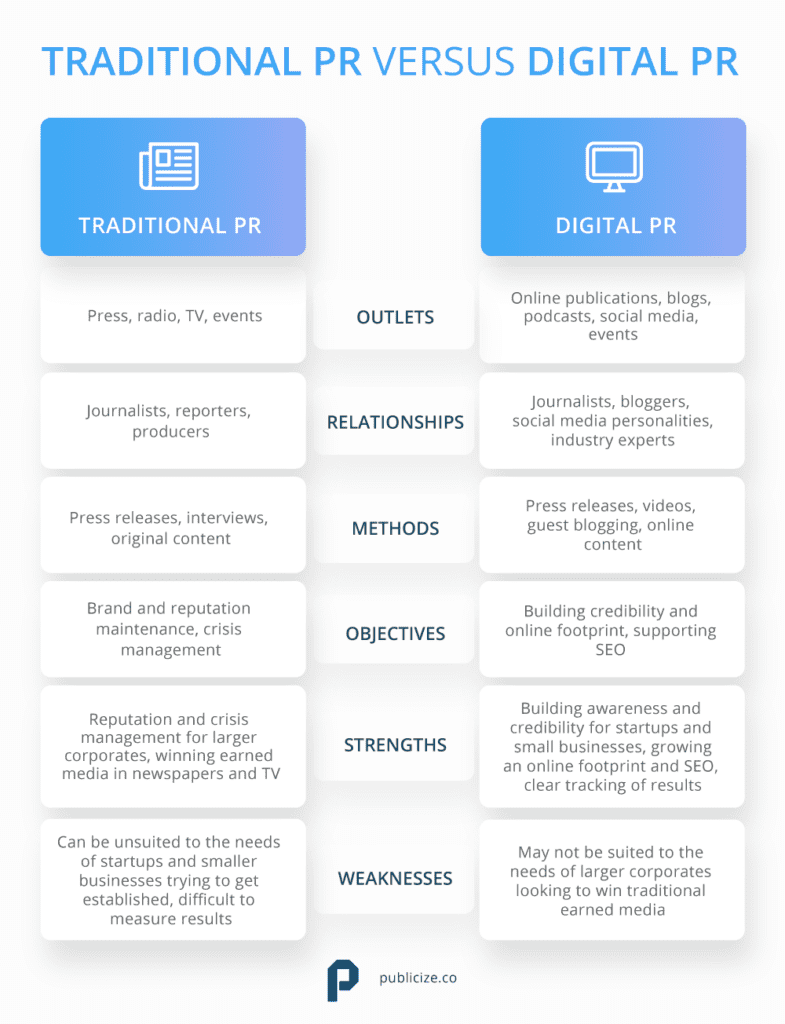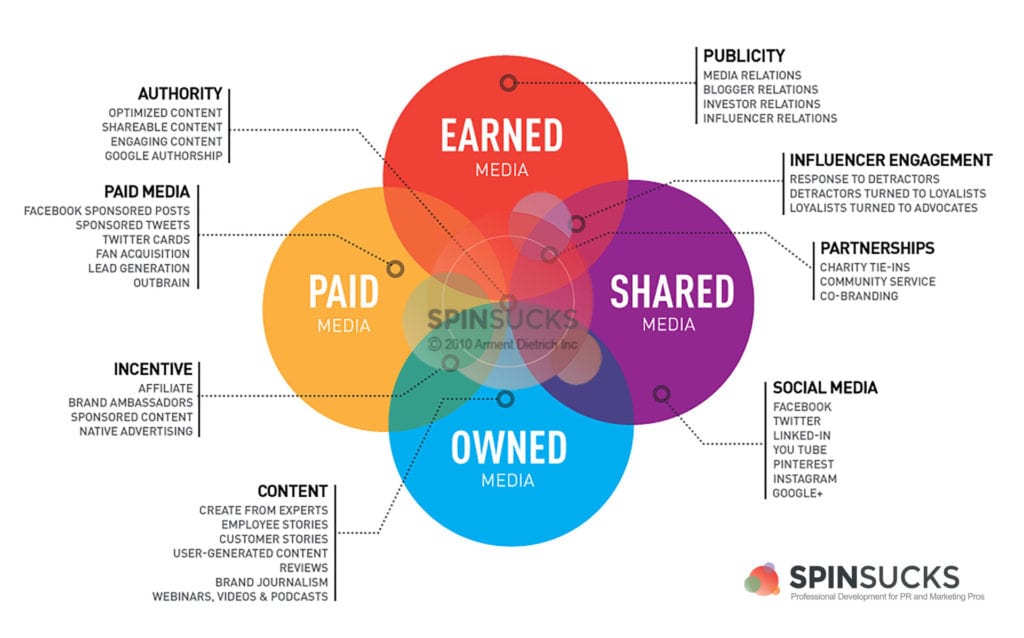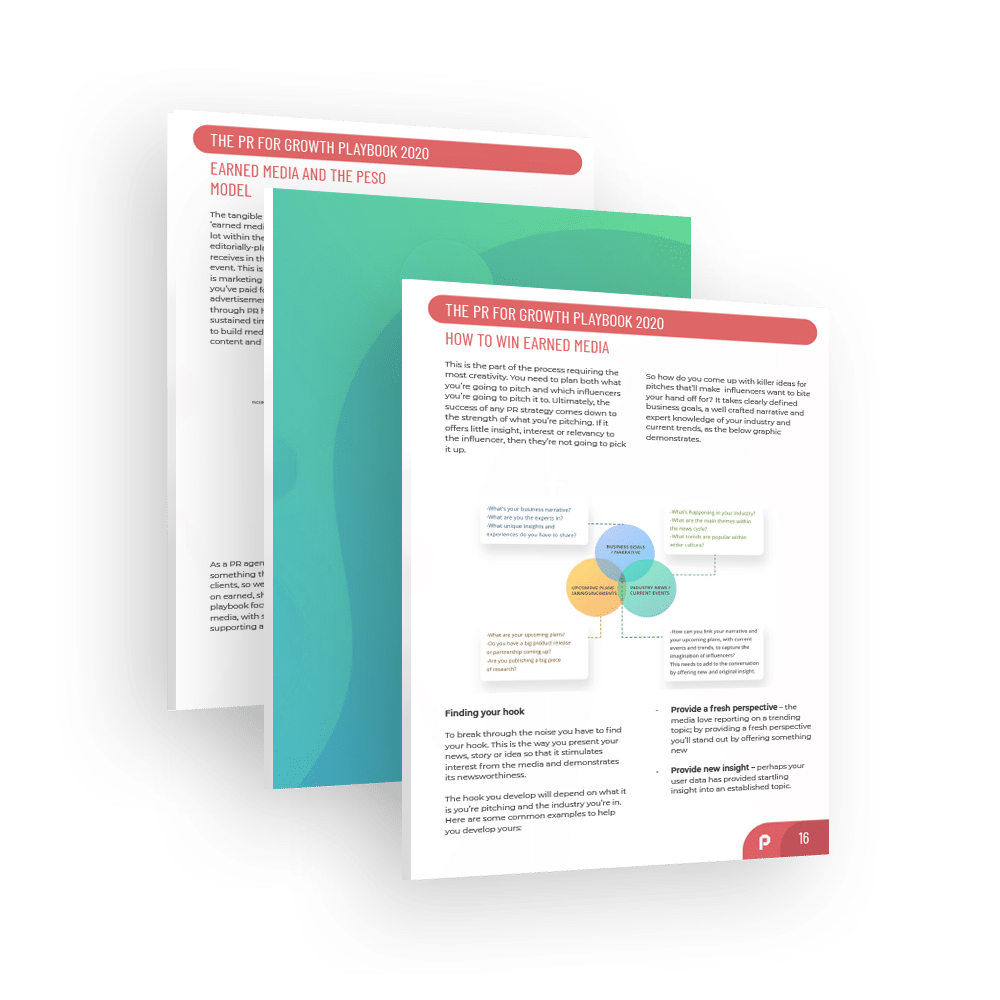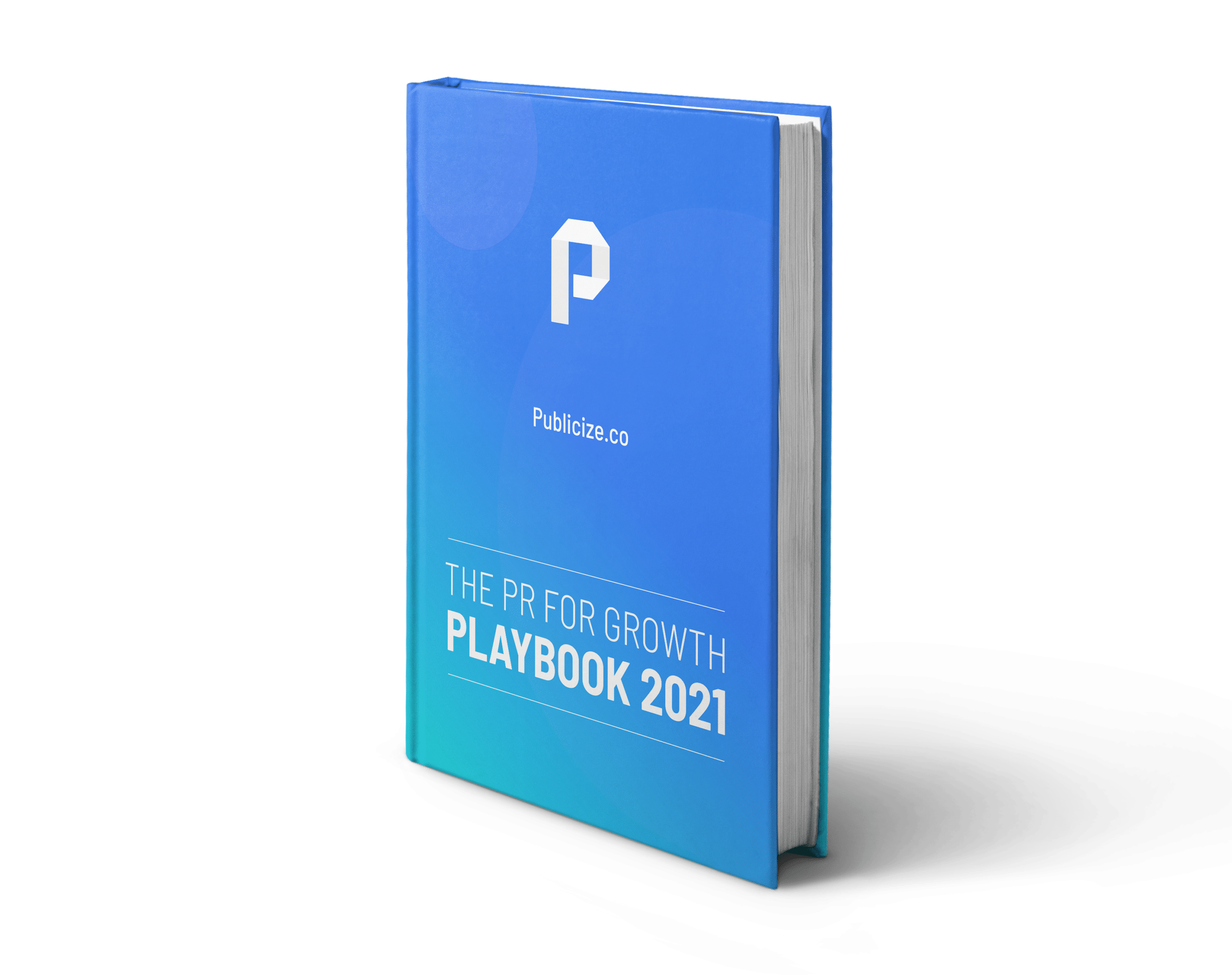For many people, public relations remains a bit of a mystery. If pushed for an answer, most will say something about press releases and crisis management. While PR does involve both of these things, this barely touches the sides!
Do you want to increase your company’s credibility, grow awareness, and build its reputation? These are the vital foundations that all businesses are based on, and this is what an effective public relations strategy delivers.
In this guide to PR we provide a step-by-step walkthrough on how to do your own PR to grow your business in 2022, let’s get it started.
What is PR
So first off, before we start explaining how to do PR, let’s define what is PR. This question stumps a lot of people and often takes up whole chapters of overly technical explanations in PR for Beginners books.
I’ll start with the textbook definition of PR, from the Public Relations Society of America:
“Public relations is a strategic communication process that builds mutually beneficial relationships between organizations and their publics.”
Not very helpful, right? Well, that’s the textbook definition, but here’s a much better explanation of what PR actually is:
“If a young man tells his date how handsome, smart and successful he is – that’s advertising. If the young man tells his date she’s intelligent, looks lovely, and is a great conversationalist, he’s saying the right things to the right person and that’s marketing. If someone else tells the young woman how handsome, smart and successful her date is – that’s PR.”
S. H. Simmons
So let’s unpack this a little. Public relations is the art of building all the positive attributes of a company into a narrative that supports the company’s goals. The media is then used to broadcast that narrative to their audiences. In PR talk, getting your business mentioned in the media, such as in an article, is termed as winning earned media.
The point in winning earned media is to create the factors required to help a company achieve its goals. A goal could be to increase sales or win new clients. A PR strategy can deliver this both directly and indirectly. Winning earned media can directly drive more traffic to a website, such as via click-throughs on backlinks. While more importantly, building credibility and increasing awareness through earned media will indirectly drive more business and improve conversions.
As the above shows, the media is the conduit through which a company delivers its public relations strategy. Therefore, building relationships with journalists, bloggers, and other media influencers is vital. How you build relationships, earn media and deliver a public relations strategy is explained in this guide to PR.
The Purpose of Public Relations
Public Relations is as a means to an end, rather than an end in itself. Winning earned media and getting a company name in print is sometimes viewed as the sole objective of PR. But this is just the means through which the broader aims of a PR strategy can be delivered. So what are these aims?
Well, these depend on the individual goals of each business. Some common examples for startups and other businesses are to secure funding, increase sales, or win new clients. The goals of a PR strategy would then be to help create the factors required to achieve these aims. These often include the following:
- Credibility – essential for any business, especially a startup, if it wants to win new clients, increase sales or attract talent. PR helps to deliver this by getting your narrative in front of your target audience and building a digital footprint.
- Awareness – once your startup or business is seen as credible, you need awareness to continue to grow. With PR, you can showcase your product and your business through media wins such as professional reviews and guest appearances.
- Social proof – this shows to potential investors, customers or employees why you and your company should be taken seriously. Social proof may be the fact you’re an industry expert or that your startup was part of a prestigious accelerator program. Earned media is used to communicate this message to your audience.
Improved search rankings – PR and SEO work hand-in-hand these days. When a business wins a piece of earned media in an online publication, this usually includes a backlink to their website. And backlinks still remain a vital ranking factor, even in 2022.
The Difference Between PR and Marketing
As discussed above, PR’s primary objective is to help create the underlying factors required for a company to succeed. On the other hand, marketing’s primary objective is to increase revenue by directly driving more business to a company.
The methods of public relations and marketing are very similar, as both rely on the media to get their message out to their target audience. The key difference here is that with PR activity, you win earned media in editorially produced content at no direct cost.
For example, TechCrunch writes a review about your product or your business gets listed on a review site. But with marketing, you directly pay for advertisements in media channels, which is termed as paid media. For example, newspaper ads, sponsored Tweets and Google Ads.
People sometimes ask “why not just put all your resources into marketing, as it has a direct and immediate impact?”
The answer is that a good PR strategy supports a company’s marketing efforts. Consumers need to have sufficient trust in a brand, before they’re willing to part with their cash. And earned media is the most effective way of building this trust. In which case, spending money on marketing before this trust has been built will limit a business’s ROI.
PR in 2022
The PR landscape in 2022 looks very different compared to just a few years ago. As such, many PR guides are already out of date.
Traditional media such as newspapers and magazines have continued their trend of ever-shrinking circulation numbers.
Meanwhile, the troubles faced by this industry stand in stark contrast to online media outlets and influencers, who now possess more power than ever. Add to this mix over 500,000 new businesses that are founded each month, all fighting to be heard.
In response to this, the PR industry, much like the marketing industry, has evolved rapidly over the last decade or so. Many within the industry now split PR activities between “traditional” and “digital”:

Traditional PR vs Digital PR
While traditional PR is still important to many companies, digital PR has arguably supplanted traditional PR in importance for many others.
For example, many startups leverage the techniques of digital PR to efficiently build their digital footprint. Whereas traditional PR activities like crisis management and brand maintenance are less important services.
Digital PR also provides secondary benefits, including natural link building via backlinks in earned media, which makes it a great combined SEO and PR activity. Quality referral traffic is also generated via click-throughs. And of course, as with anything digital, progress such as online mentions, social shares, site visits and organic positions can be tracked and measured, on a click by click basis.
Crisis Management
Wait, didn’t we already say crisis management is traditional PR and less relevant to the modern day?
Well, for the majority of the time yes. However, the world is now a difficult place to live in and businesses are suffering as a result. Global pandemics and environmental disasters can definitely occur, and these put untold pressures on a variety of industries.
What should businesses do in the face of a crisis?
Well, there are actually several courses of action you can take to make your business’ voice heard.
As well as addressing stakeholders with an effective press release, you can host live streams to keep connected with your target audience.
Furthermore, newsjacking can get you great media coverage in times of news saturation, if it’s done in good taste.
Inbound PR
You can view Inbound PR as an extension of digital PR. It combines the content creation and media outreach of public relations, with the metrics and measurement of inbound marketing.
This approach to PR allows businesses to better quantify their ROI and optimize their strategy more effectively as they go.
For example, if you’re not getting the share of voice you set out to achieve, you can analyze weak spots with your data and tweak your pr strategy.
Here’s an infographic explaining the inbound PR process in more detail.
Video PR & Audio PR
When considering a robust PR strategy, the importance of audio and video content can’t be denied.
If the 2010s sparked the rapid rise of online multimedia content popularity, the 2020s is the era of its online domination. Statistics already confirm this:
In 2021, 84% of consumers have cited video as the convincing factor in a purchase they have made and by 2022 it’s predicted that staggering 82% of all B2C and B2B web traffic will come from video.
What does this mean for businesses looking to integrate multimedia content onto their site? That embedded video and audio site content bolsters your SEO efforts.
Furthermore, producing owned multimedia content develops a business’ brand awareness, giving them exposure to new audiences on platforms like YouTube and Spotify.
Whether it’s producing podcasts for pr purposes, or audio versions of your written content, multimedia content demonstrates legitimacy and credibility, building trust with your audience.
Understanding Earned Media – the Core Output of PR
So as the above explains, the main point of PR is to help companies and brands build factors such as trust, legitimacy and reputation. These are the foundations that all companies need, in order to grow and achieve their goals. And you build these factors by getting your narrative into earned media.
What is earned media exactly?
When we refer to earned media for PR, we mean any channel or medium of influence, that has some form of editorial control. You win earned media by offering something that’s considered to be editorially relevant to that media’s target audience. Some common examples of earned media include getting mentioned in a newspaper article or receiving a professional review.
It’s also important to place earned media in context. A combined marketing, communications and PR strategy has four broadly defined media channels that can be leveraged. Earned media is one of these.
The PESO Model
The best way of visualising this is by using the PESO model, which was created by Gini Dietrich, author of Spin Sucks

As the model shows, businesses have four media channels through which to reach their target audience:
Paid media is the domain of marketing, so doesn’t form part of a public relations strategy. But shared and owned media both play an important role in supporting a do it yourself PR strategy.
Content produced on owned media, as part of a content strategy, can be picked up by media outlets and become an earned media win. At the same time, owned media content also plays an important part in supporting the narrative you’re trying to build through earned media.
Shared media, meanwhile, can be used to amplify any earned media wins, such as retweeting and sharing any links to earned media. Shared media is also an important tool for building relationships with media influencers, the gatekeepers to earned media.
So all three of these channels need to work in tandem if you want to create an effective PR strategy.
What is a Media Influencer
Many people believe this to mean only social media influencers, or influencer marketing (which isn’t PR at all). When it comes to public relations, this simply means anyone who’s an opinion former or trendsetter, or who can amplify your message to an audience.
To be an opinion former or trendsetter, you need a following and a platform, as well as respectability and authoritativeness. This was a pretty self contained list in the pre-digital media era, such as journalists, columnists, industry experts, and tv and radio producers. But in today’s fragmented media landscape, there are many different types of influencers.
Why They’re So Important
Influencers are the gatekeepers to earned media. To snag an interview on a top business podcast, get a marketing guru to mention your company, or have your product featured in TechCrunch all relies on winning over influencers. Firstly you need to identify influencers relevant to you, your industry and your brand, then work hard over the longterm to build relationships with them.
How to Find Relevant Influencers
Targeting the correct influencers is a vital part of a PR strategy. Work through these steps to identify the influencers that are the most relevant to you and your PR strategy goals:
What are you trying to achieve with your PR Strategy?
Who do you need to reach to achieve those goals?
What media do they consume?
Who are the influencers operating within this media that are the most relevant to your brand and your message?
Micro-Influencers
We mentioned above that there’s different types of influencers. But are some influencers better than others for helping you achieve your PR goals?
The answer’s yes.
Most people believe that the power of an influencer is defined by the number of followers he or she has on a particular social media channel. While this can be true some of the time, it’s not necessarily the case for companies with business growth objectives.
Let me give you an example. If Kim Kardashian tweets saying she used your piece of ed-tech software, your business’ going to get lots of attention. But this attention’s less likely to convert into customers.
However, a famous educational institute with less followers tweets about you, the subsequent engagement from their audience has a higher chance of being meaningful to your business.
Welcome to the world of micro-influencing.
Micro-influencers are typically individuals with tens of thousands rather than hundreds of thousands of followers. But their followers’ interests are better refined, meaning engagement on their social media channels is more valuable to particular industries.
In pursuit of some prized earned media, your business should consider whose influence is more valuable to its PR objectives.
How to do PR
As we’ve already established, PR helps increase your company’s credibility, brand awareness, and build a reputation. With that in mind, here’s how to do it effectively for your company:
- Set your PR goals and review them on a regular basis.
A successful PR strategy helps your company to grow digitally and contributes to achieving a wider business objective. This objective varies from bringing in new clients, increasing sales, improving your brand’s image or building a meaningful relationship with your audience. Make sure these goals are SMART – specific, measurable, attainable, realistic and time-sensitive.
- Research your audience for better targeting.
It’s key to understand who your buyer persona is, that being an ideal or current customer. This will help guide your PR strategy to reach higher customer engagement levels by defining who your target audience is and how to address them effectively.
- Decide on the platforms and channels that work best for your message.
To increase the chances of success when executing a PR strategy, identify which platform your audience prefers to help spread your message. Every business has four media channels to reach their target audience: Paid, Earned, Shared, and Owned (known as the PESO model). Each of these channels must work in tandem to ensure a successful PR strategy.
- Pitch your stories to the media.
Once you have the list of journalists you want to contact, work on your pitch. Some main PR pitches are press releases, guest articles, product reviews, guest appearances and expert commentary. Your pitch’s strength will dictate the success behind how to do PR for your company.
- Measure your PR results.
It’s imperative that every PR impact is measured and tracked, just like any other business function. Some key KPIs are website referral traffic, lead volume, conversion, organic traffic, and social engagement.
Pitching to Journalists and the Media
Once you’ve come up with a killer idea to win earned media, you then need to pitch it. Who your target audience is will dictate which journalists, reporters and other media influencers you pitch to.
Read our post on how to find journalists’ contact details and our guide on how to pitch to journalists to do this.
When you have your list of journalists to contact, you then need to write the pitch. Here are some of the main types of PR pitches:
- Press releases – a quick and efficient way of sending information to journalists and reporters. Learn when and how to write a press release.
- Guest articles – penning your own guest article and sending this to publications is a great way to win earned media “in your own words”. Follow these tips on how to write a guest article.
- Product reviews – to get your product professionally reviewed, such as on CNET, will usually require pitching it to your target media outlets.
- Guest appearances – landing guest appearances, such as on industry podcasts or at speaking engagements, are another great way of winning earned media “in your words”.
- Expert commentary – providing journalists or reporters with your expert opinion on a topical news event is a brilliant way to start building long term relationships.
Your DIY PR efforts live or die on the strength of your pitch. Keep it short, concise and on point. Here’s an example pitch to a journalist, with the aim of securing an expert comment, interview or guest article discussing how tech is reshaping an industry:
SUBJECT: [NAME] – Story Pitch: Opportunities in Latin America’s banking sector abound for global tech firms
Hi [NAME]
With over 45% of the population lacking a bank account in Latin America and VC firms showing a willingness to back new entrants to the market, the opportunities for tech and startup firms to compete in what is basically virgin territory seems very promising. The trends have already begun with fintech investment tripling in growth from 2015 to 2016 and more than doubling in growth from 2016 to 2017.
[YOUR NAME] is the co-founder and CEO of [COMPANY NAME], a global fintech company headquartered in Brazil that offers local payment solutions from Latin America for merchants. She is keen to offer her unique insights on this emerging sector and can speak as an expert on the following topics:
- The new cultural shift in the startup landscape that will allow startups to help small businesses across the region.
- Which types of tech firms and which industries seem the most competitive and promising
- How and why Latin American fintech firms are proving to be just as attractive to investors as US-based counterparts
[YOUR NAME] would be more than happy to provide expert commentary for any future stories on this subject. She is also available for interviews, or could even pen an article on this topic which could provide your readership with great insight and actionable takeaways.
All the best,
How to measure PR Results
The ROI of PR, just like any other business function, needs to be measured and tracked. A common misconception is that the effects of PR are intangible and can’t be quantified.
It’s true that in the pre-digital era measuring the impact of PR could be difficult. But in the digital age, that’s all changed. And while you can’t necessarily put a number on credibility, there are many other things you definitely can and should measure.
Key Output Metrics
These are measurements of your earned media wins. As winning earned media is a means to an end, rather than an end in itself, these measure the outputs of this. This enables you to see if you’re on the right track with your media wins.
Key output metrics include:
- Mentions – how many mentions did you get in different pieces of earned media
- Share of Voice – the number of mentions you received versus competitors
- Backlinks – how many backlinks you won through earned media
- Sentiments – qualitative assessment of what is being said about your brand in earned media wins
- End audience reach – qualitative assessment of whether the media outlets containing your earned media wins are consumed by your target audience
PR KPIs
Key performance indicators (KPIs) measure the impact of your PR activity against your PR goals. As your PR goals are dependent on your business goals, KPIs can vary from company-to-company.
Common KPIs include:
- Website referral traffic – how much traffic is landing on your site from earned media referrals
- Lead volume – how many leads are you capturing and where are they coming from
- Conversion – how is lead closure rate tracking relative to key output metrics
- Organic traffic – what’s your share and volume of organic traffic, relative to positional gains
- Social engagements – how many people are engaging with your content and social channels
Regular media monitoring is essential in order to gather the data for this.
So these are the broad strokes of how to do your own PR. This guide to PR has shown you what is PR, what it’s used for, and how to win media coverage and measure your PR results.
Final thoughts
And a final point to end on, which is also a very important one.
PR, like most business functions, is something that requires continuous effort. Sending out a press release as and when you have something to announce is no longer an effective strategy in 2022.
You need to build relationships with the media and continually offer them interesting and original content. Over time, as your media wins start to increase and your brand becomes more established, you’ll start reaping the rewards that this brings.Now you’ve read our guide to PR, download our PR for Growth Playbook 2022. This is a PR for beginners playbook, providing a step-by-step guide on how to create a PR strategy that will boost your company’s growth.










